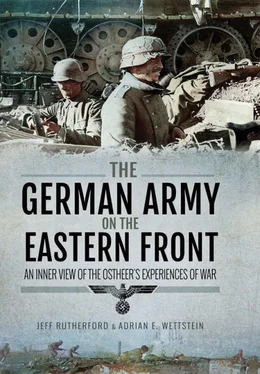My visit to the frontline positions prompts me to make the following remarks:
1) The troops in the main combat zone have to be richly equipped with close combat anti-tank devices (stun grenades, smoke grenades, Molotov cocktails, 5 or 10kg explosive charges, adhesive charges). The satchel charge of 6-7 hand grenades is ineffective against the tank.
2) The submachine gun is one of the most effective defensive weapons against assaults. It belongs in the main combat line and not as a private weapon for leaders of rear units. Ample ammunition is the prerequisite for effectiveness. A submachine gun requires 1,000 bullets. The rifle companies’ platoon and company leaders must have assault troops, equipped with submachine guns and numerous hand grenades, at their personal disposal.
3) Heavy machine guns belong in the depth of the main combat zone. Flanking machine guns with ample ammunition firing in front of the main combat line are an effective protection for wire entanglements and mine fields with weak trench troops. Where the wire entanglements are incomplete, the use of heavy machine guns flanking the gaps is necessary. Against hostile skiers who approach the main battle line under protection of night and fog, single wires are already effective.
4) In the case of a large sector width and low [troop] strength, it is not appropriate to distribute the men individually or in twos over the whole section. The man feels lonely and fails during an enemy attack. Groupings of at least 4 or 5 [men], as well as ample equipment with hand grenades and submachine guns, give more security. If there is a danger that an enemy assault detachment can penetrate the trenches between 2 such posts, trap doors (simple wooden frames covered with barbed wire) in the trench will give flank protection to the posts.
5) Battalion and regimental command posts are to be urgently expanded to strongpoints. Such a strongpoint must be at least some 100m in diameter, and include anti-tank capabilities and artillery observation. Linkage with another strongpoint, i.e. battery positions, is advisable.
6) Each command post, including up to the divisional level, has to set up one or more observation points on the battlefield, with a view of the main combat line, so that it receives immediate reports about where the apparent hotspots of the battle are developing. At the divisional and regimental command posts, reconnaissance patrols led by officers have to be held ready, in order to be sent to the critical positions for immediate reporting. Waiting for reports from subordinate commands is incorrect.
7) Due to the extent of the [defence] sectors, in no case can one count on artillery protection by barrage fire. Unobserved firing of the artillery on fire areas and target points is a makeshift measure for night and fog. The task of artillery battalion commanders is to concentrate the fire of their battalion (group) on recognized targets and to strengthen [it] if possible by the fire of neighbouring batteries. If numerous targets are on the battlefield, he must, in close connection with the infantry, decide on the order in which the objectives are to be combated with a concentrated fire. The fragmentation of fire by assigning targets to the individual batteries is erroneous. The rapid change of target by as many batteries as possible is to be constantly trained by the artillery leaders. Continual verification of this ability by the artillery leaders and by the sector commanders is required.
8) The scattering of individual batteries in the area is disadvantageous. It makes the fire concentrations more difficult, reduces the influence of artillery leaders; the signal communications are sensitive and require numerous personnel for their maintenance. If the enemy advances as far as the battery positions, the individual battery easily falls prey by the encirclement, especially since the crew is usually weak while in the fire positions.
9) Divisional boundaries must not be blinders for artillery. Artillery battalions located at these boundaries must possess their neighbour’s radio information, so that the observation points can fire with the neighbouring batteries.
10) Heavy ATG belong in the main combat line only in exceptional cases. They easily become the victim of the enemy’s fire preparations there. They are better positioned in the depth of the main combat zone. Each major fighting action proves the necessity of a grouped positioning of the ATGs. The influence of the platoon leader must be preserved. A reserve of men and ammunition must be found with the company leaders. The mobility of the ATGs must be ensured, so that concentration at threatened points is possible.
11) The rather middling enemy preparatory fire on 25.11. has caused individual divisions not inconsiderable losses. Once again, I point out the need to deepen the trenches in spite of the frost and to make as many foxholes as possible. In the splinter-covered foxhole, only a direct hit can cause damage to the man. The winter clothing allows the man to stay in the foxhole for a long time without any damage to his health.
These remarks cover many issues that were not commonly addressed in the German army due to the lack of comprehensive defensive manuals. But they also point to tactical weaknesses present in the army, such as a lack of awareness of boundaries or the correct positioning of the ATGs. At the same time, one can see the efforts to overcome such issues. Finally, positional warfare in the Soviet Union significantly differed in one way from German experience (and our picture of that kind of warfare stemming from the First World War Western Front), namely the enormous length of the front line, which neither allowed for an elaborate construction of field fortifications, nor for a strong occupation of the trenches. In many sectors, such as on the boundary of the Army Groups North and Centre in the area between Velikiye Luki and Demidov, there was not even a continuously manned line.
One of the tactical elements that the Germans had to relearn on the Eastern front, and especially under positional warfare conditions, was the use of snipers. For readers closely acquainted with the campaigns in Italy and northwest Europe, this sounds rather puzzling, as snipers there were a feared part of the German defence. While the German army in the First World War achieved a high standard of sniping, most of that was lost in the late Reichswehr period and during the rearmament years. Few German divisions possessed telescopic sight rifles when entering the Soviet Union and special sniper training was more or less non-existent. The clash with Soviet snipers, the rise of positional warfare in large sections of the Eastern front, and the recognition of the need for precise fire on the smallest tactical level led to a renaissance in German sniping starting in 1942, but major progress was made in 1943 with expansion of training units and an increased production of weapons. The products of these efforts were the snipers encountered by the British and American troops in the west from 1943 on. Experiences for sniper training were gathered from the allied Finns, who had a particularly well-developed sniper branch and plenty of practical knowledge from the Winter War. The Soviet use of snipers was also closely observed. Before the start of systematic sniper training in the Replacement Army, the field units improvised training facilities themselves. For that purpose, leaflets were produced, such as the following one from XIIIth Army Corps, fighting in the Don area under 2nd Army: [23]
A) Leaflet for snipers
1) Be proud of your weapon. There are many other weapons in the company, but only 4 telescopic sight rifles.
2) Maintain your rifle carefully. Then you can always rely on the weapon.
3) Be like the hunter! With perseverance, cunning, and calm blood, one hunts down game as well as the Bolsheviks.
Читать дальше






![John Stieber - Against the Odds - Survival on the Russian Front 1944-1945 [2nd Edition]](/books/405234/john-stieber-against-the-odds-survival-on-the-russian-front-1944-1945-2nd-edition-thumb.webp)





